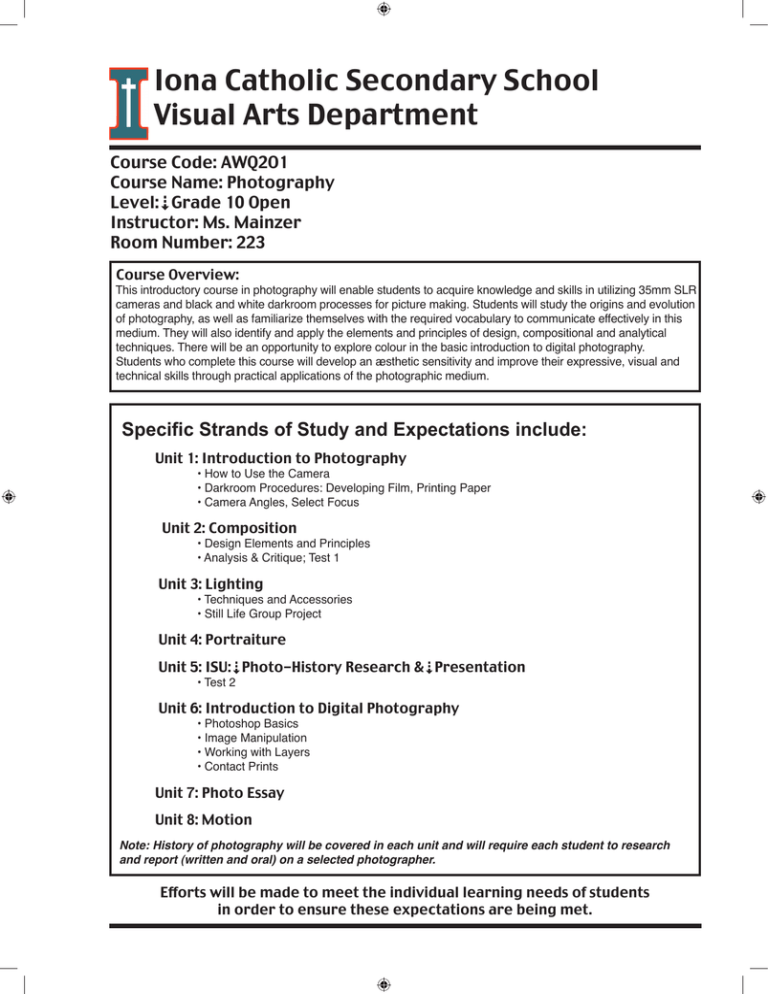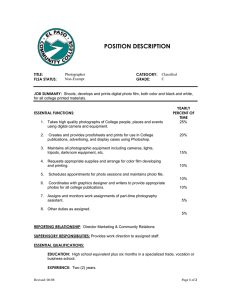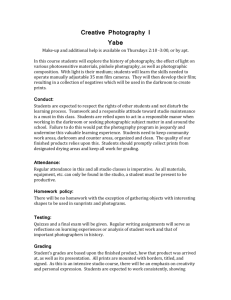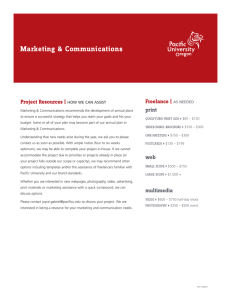Iona Catholic Secondary School Visual Arts Department
advertisement

Iona Catholic Secondary School Visual Arts Department Course Code: AWQ2O1 Course Name: Photography Level:⇣Grade 10 Open Instructor: Ms. Mainzer Room Number: 223 Course Overview: This introductory course in photography will enable students to acquire knowledge and skills in utilizing 35mm SLR cameras and black and white darkroom processes for picture making. Students will study the origins and evolution of photography, as well as familiarize themselves with the required vocabulary to communicate effectively in this medium. They will also identify and apply the elements and principles of design, compositional and analytical techniques. There will be an opportunity to explore colour in the basic introduction to digital photography. Students who complete this course will develop an aesthetic sensitivity and improve their expressive, visual and technical skills through practical applications of the photographic medium. Specific Strands of Study and Expectations include: Unit 1: Introduction to Photography • How to Use the Camera • Darkroom Procedures: Developing Film, Printing Paper • Camera Angles, Select Focus Unit 2: Composition Unit 3: Lighting Unit 4: Portraiture Unit 5: ISU:⇣Photo-History Research &⇣Presentation Unit 6: Introduction to Digital Photography • Design Elements and Principles • Analysis & Critique; Test 1 • Techniques and Accessories • Still Life Group Project • Test 2 • Photoshop Basics • Image Manipulation • Working with Layers • Contact Prints Unit 7: Photo Essay Unit 8: Motion Note: History of photography will be covered in each unit and will require each student to research and report (written and oral) on a selected photographer. Efforts will be made to meet the individual learning needs of students in order to ensure these expectations are being met. Resources: AWQ2O1 The course will use a variety of resources to provide students with a comprehensive learning activity: • Students are responsible for keeping organized notes of lecture material - including missed classes; • Handouts and reprints of articles; • Print and on-line internet research; • Returned tests, quizzes and examples of photographic work should be kept for study reference; • In-class screenings of videotaped programs; Evaluation Structure: Term and Summative work is weighted in 4 categories • Knowledge/Understanding.......20% • Thinking/Inquiry........................20% • Communication........................20% • Application................................40% The above is reflected in the term work (worth 70% of the final mark) and the summative work (worth 30% of the final mark) Summative work consists of: 10% Culminating Activity Evaluation Policy Students will be assessed and evaluated according to the work produced and skills displayed. Methods of providing feedback will include assessing work in process and evaluating completed assignments, tests, co-operative learning activities, simulations and presentations. Peer and self-evaluations will also be utilized. Student marks will be determined by evaluating process and product according to 4 categories and 4 levels. The chart below defines the specific skills and key words used to determine student competency in the different categories: Category Level Level 1: 50 - 59% Knowledge &⇣Understanding Limited • Knowledge of facts and terms • Understanding of concepts and relationships Thinking & Inquiry • Critical thinking skills • Creative thinking skills • Inquiry skills Communication display of knowledge, skills and ability to apply concepts. Level 2: 60 - 69% Some success in displaying knowledge, skills and application of concepts. Level 3: 70 - 79% Level 4: 80 - 100% Considerable display of knowledge, skills and ability to apply concepts. Thorough understanding of concepts and ability to communicate, think creatively and apply concepts. • Communication of ideas and information • Use of symbols and visuals • Oral and written presentation Application • Applications in familiar contexts • Transfer of concepts to new contexts • Making logical conclusions and predictions • Use of technology The following student learning skills are assessed independently and feedback provided on reports: Working Independently, Team Work, Organization, Work Habits and Homework, and Initiative. E⇣= Excellent G⇣= Good S = Satisfactory N = Needs Improvement Other Evaluation Issues • Students are responsible for the safe use of all camera, lighting and darkroom equipment, and must return a signed copy of the Parental Consent letter with the Course Material Fee before using equipment; • Repeated lateness in submitting work indicates poor organization skills and will result in parental contact; • Students are obliged to follow the Board’s policy on computer use any misuse will result in consequences; • Plagiarism, in any form, reflects academic dishonesty and will reult in a mark of zero for the assignment; • Students are expected to be prepared for all class work, and attend wearing the full Iona uniform properly; • All students are bound by the policies and procedures detailed in the Iona Student Agenda, with consequences as outlined - including administration involvement and parental contact. I Iona Catholic Secondary School Visual Arts Department Course Code:⇣AWQ2O1 Course Name:⇣Photography Level:⇣Grade 10 Open Instructor:⇣Ms. Mainzer Room Number:⇣223 Course Overview: This introductory course in photography will enable students to acquire knowledge and skills in utilizing 35mm SLR cameras and black and white darkroom processes for picture making. Students will study the origins and evolution of photography, as well as familiarize themselves with the required vocabulary to communicate effectively in this medium. They will also identify and apply the elements and principles of design, compositional and analytical techniques. There will be an opportunity to explore colour in the basic introduction to digital photography. Students who complete this course will develop an aesthetic sensitivity and improve their expressive, visual and technical skills through practical applications of the photographic medium. Specific Strands of Study and Expectations include: Unit 1:⇣Introduction to Photography • How to Use the Camera • Darkroom Procedures: Developing Film, Printing Paper • Camera Angles, Select Focus Unit 2: Composition Unit 3:⇣Lighting Unit 4:⇣Portraiture Unit 5:⇣ISU:⇣Photo-History Research &⇣Presentation Unit 6:⇣Introduction to Digital Photography • Design Elements and Principles • Analysis & Critique; Test 1 • Techniques and Accessories • Still Life Group Project • Test 2 • Photoshop Basics • Image Manipulation • Working with Layers • Contact Prints Unit 7:⇣Photo Essay Unit 8:⇣Motion Note: History of photography will be covered in each unit and will require each student to research and report (written and oral) on a selected photographer. Efforts will be made to meet the individual learning needs of students in order to ensure these expectations are being met.






